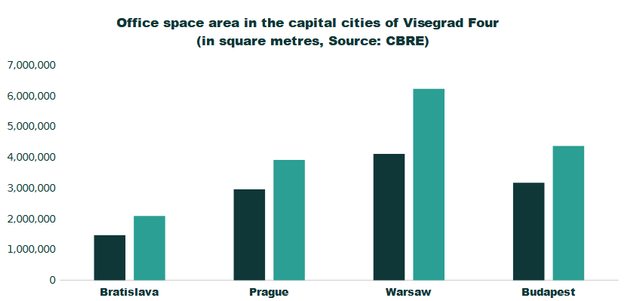Among the capitals of the Visegrad Four countries—Slovakia, Hungary, Czechia, and Poland—Prague continues to boast the highest standard of living. However, Warsaw has emerged as the “rising star” of the decade, according to an analysis by WOOD & Company.
One of the most commonly accepted indicators of regional living standards is GDP per capita. Within the Visegrad Four capitals, the region of Prague leads the pack, boasting 207 percent of the European Union average (EU27 = 100 percent). Following closely is the Warsaw region, which records 162 percent of the EU average. Strikingly, the city of Warsaw alone reached 220 percent, marking a significant leap from its 195 percent standing in 2012. Meanwhile, Budapest registers at 158 percent, and the Bratislava region stands at 146 percent.
“The Visegrad Four countries, and their capitals in particular, have undergone a transformative decade,” said WOOD & Company’s analyst Eva Sadovská.
Population growth
They have not only rebounded from the global financial crisis but have solidified their roles within the EU. Slovakia, for instance, has fully integrated the euro. Yet, these capitals have also faced significant headwinds, including the Covid-19 pandemic, the war in Ukraine, and the energy crisis.
Despite these challenges, the population of all Visegrad Group capitals grew over the past 10 years, even as some countries saw overall population declines.
Above-average living standards and purchasing power in these capitals are further bolstered by low unemployment rates. Notably, none of the observed capitals experienced substantial declines in employment during the pandemic. In fact, as coronavirus restrictions eased, unemployment rates in these regions began to fall again. In 2023, Warsaw led with the lowest unemployment rate at 1.9 percent, followed by Prague at 2.1 percent. Bratislava and Budapest both posted an unemployment rate of 2.3 percent last year.
Booming office space expansion
More modern indicators of urban growth, such as the expansion of office buildings, shopping centres, logistics hubs, industrial parks, and residential complexes, offer valuable insights into the economic trajectories of these capitals. The pace of development in these areas mirrors both current and anticipated economic growth.
“Over the past decade, all Visegrad Four capitals have experienced a real estate boom, with significant increases in office space,” noted Sadovská.
According to CBRE, Warsaw saw the most dramatic expansion, with office space growing by 51 percent to 6.23 million square metres as of 2023. Bratislava’s office space surged by over 42 percent compared to 2013, reaching 2.09 million square metres. Budapest followed with a 38-percent increase to 4.37 million square metres, while Prague saw a 32-percent rise to 3.91 million square metres.
“Investing in retail centres and office buildings in cities like Prague and Bratislava is already familiar territory for Slovak investors, who often leverage real estate funds to acquire assets that would be out of reach individually,” the analyst said, adding that Warsaw is rapidly emerging as a new focal point for investment.
Warsaw attracting real estate investors
The growing appeal of Warsaw is underscored by the “Investor Intentions Survey 2024” conducted by CBRE at the end of 2023. This survey, which gauged the preferences of European real estate investors, ranked Warsaw among the top locations for investment.
The Polish capital secured eighth place on the list of the “Top 10 Investment Destinations”, alongside major European cities like London, Paris, and Berlin. Among the Visegrad Four capitals, Warsaw earned the highest rating from real estate investors.
Poland also performed well in the European rankings as a country, placing third behind the UK and Germany.



 Bratislava in November 2023. (source: TASR - Dano Veselský)
Bratislava in November 2023. (source: TASR - Dano Veselský)
 Office space area in the Visegrad Group capitals in 2013 (black) and 2023 (green). (source: CBRE/Wood & Company)
Office space area in the Visegrad Group capitals in 2013 (black) and 2023 (green). (source: CBRE/Wood & Company)